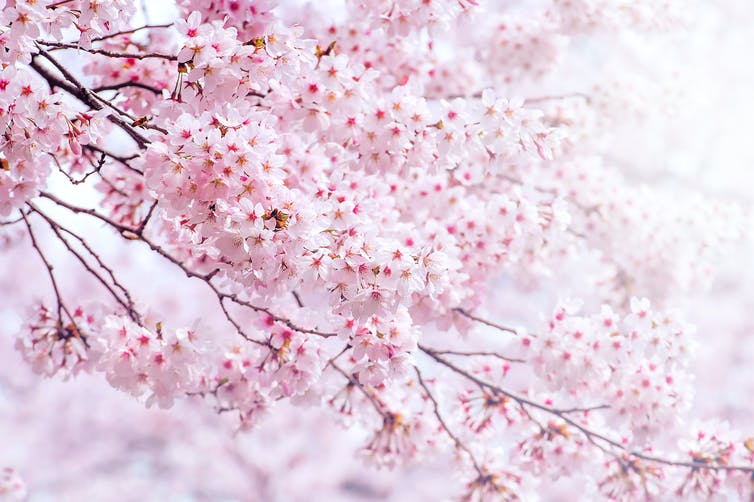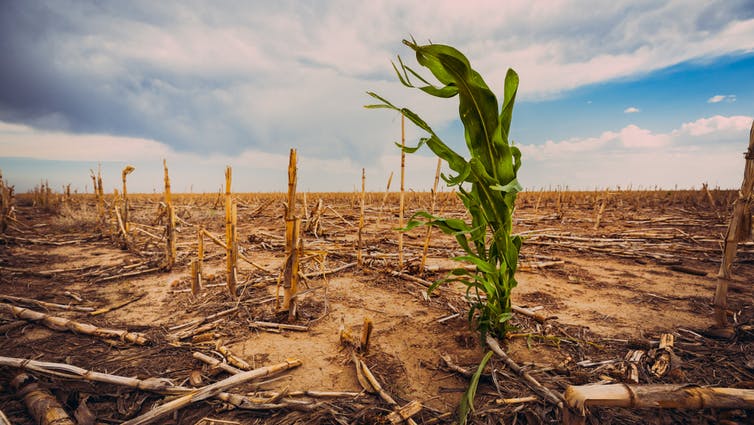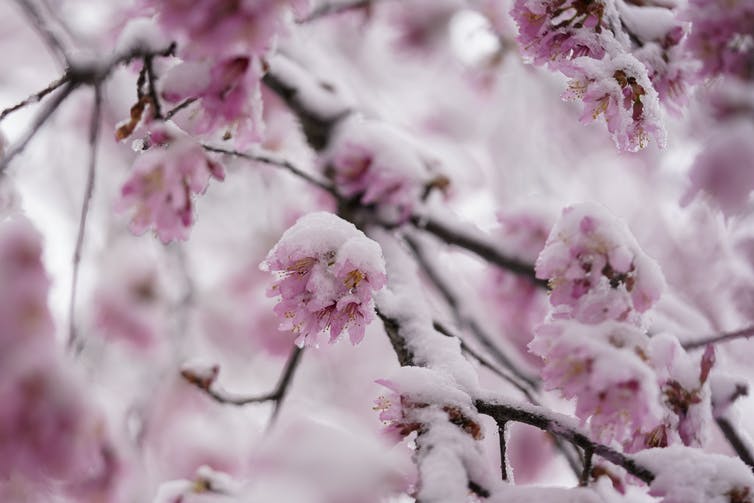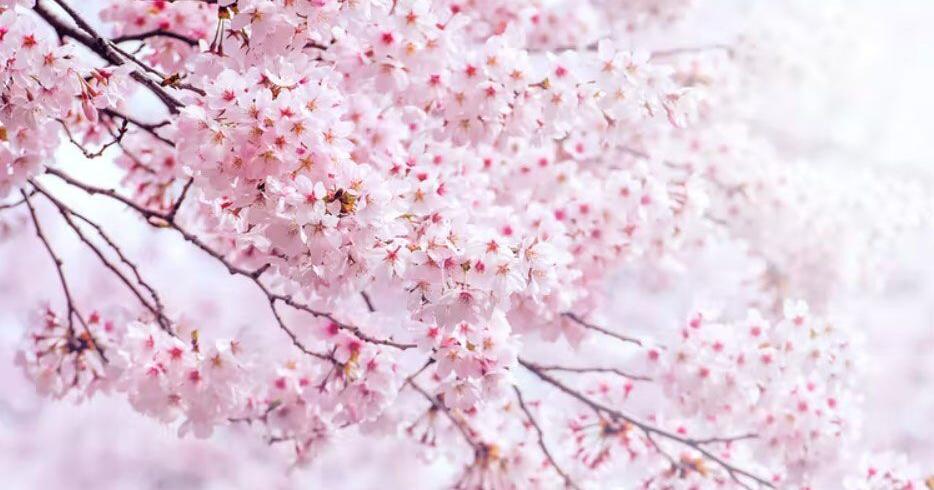
Changes in climate affect the timings of various points in the life cycle of plants, including when flowers bloom in spring and when leaves wither in autumn.
“Si sta come d’autunno sugli alberi le foglie.”
“We are like autumn leaves on branches,” Italian poet Giuseppe Ungaretti wrote in his 1918 poem Soldati (Soldiers), on the tragedy of human life and war.
If the popular image of autumn is decadence and nostalgia after the summer heat, spring is the season of rebirth after the darkness and cold of winter. The transformative passing of seasons has historically represented a powerful mental image, rich in symbolism. The seasonal timings of biological events are also an essential aspect of plant adaptation and can also be of crucial economic relevance.
People are also reading…
However, as forest ecologists, we have observed that climate change has been modifying the timing of recurrent plant life-cycle events, thus critically affecting the ecosystem.
The plant’s clock
In spring, flowers bloom. In summer, fruits ripen. In autumn, leaves change color and fall. In winter, plants rest. This is phenology — the study of the timing of recurring life-cycle events.
The life-cycle of plants, animals and all life forms depends on the environment around them.
So how do plants recognize the passage of time and the right moment to accomplish growth and reproduction? Like people, plants have their own calendar. A plant’s clock is represented by cycles in the environmental conditions, and the timing of phenological events is controlled by climate.
Specifically, plants use a set of triggers to synchronize the timings of growth and reproduction with favorable environmental conditions.
Depending on the species, phenological events are triggered by temperature (autumn and winter chilling and spring warming), photoperiod (length of day), precipitation or, often, a combination of these.
If climate changes, phenology changes
Phenology is one of the most sensitive biological indicators of the changing climate. Under the progressive rise in temperature experienced in the last century and the variations in seasonal distribution of rainfall events, the environmental triggers usually occur earlier and earlier.
This is why phenological shifts have been observed worldwide, and contextually, it seems that phenological events are occurring earlier year by year.
Japan’s Sakura or cherry blossom season is one of the most evident proofs of this shift. Dating back to the ninth century, the date of flowering, which defines the festival’s timing, has been anticipated in the last century by the rise in average temperatures.
What is the problem? Spring is cool, right?
American poet Anne Bradstreet said, “If we had no winter, the spring would not be so pleasant.” While this is hyperbolic, we still need to consider that the timings of flowers blooming, fruits ripening and other such phenological events result from a long-lasting adaptation of each species to its surrounding environment.

Changes in the environment can have economic consequences as it affects the quantity and quality of agriculture and forestry products.
The timing of phenological events are calibrated to ensure the perfect environmental condition needed to accomplish the annual cycles of a plant’s life while minimizing the risk of damage. Changes in these conditions can have ecological as well as economic consequences as they can affect the quantity and quality of agriculture and forestry products.
At the end of the growing season, plants develop dormant buds to protect the sensitive meristematic cell layer — tissue in which cells maintain the ability to divide throughout the life of the plant — and suspend activity. Dormancy is an adaptation mechanism evolved in climates with seasons to escape harsh winter conditions.
Warm spring temperatures (called forcing), the increase in day length during spring (photoperiod), and the length and intensity of winter temperatures (chilling) reactivate the growth of the apical buds — the buds located at the top of the plant — in the spring. Clearly, temperature has a central and leading role in this process. For this reason, warming can trigger an earlier reactivation in spring and a delayed cessation in autumn, or both, lengthening the growing season.
Some believe that a longer growing season could enhance carbon uptake and, therefore, the productivity of forests. In some places, such as regions in the northern latitudes or elevated altitudes, trees have profited from a longer growing season and, more generally, more favorable climatic conditions under global warming.

Late frosts in spring and early frosts in autumn, that often accompany longer growing seasons, increase the risk for damage to plants and trees.
(AP Photo/Carolyn Kaster)
However, an earlier growth reactivation increases the risk of damage due to late spring frosts, and lengthening of the growing season increases the risk of damage by early autumn frosts.
If trees cannot adapt, or re-adapt, their phenology with the new climatic conditions, the fitness and growth performance of local populations could be dramatically affected.
If phenology changes, species interaction changes
Ecosystems are generally complex and the species within them interact with each other as well as their surrounding environment. Different species can react differently to the changing climatic conditions, potentially leading to dangerous new phenological matches or mismatches.
For example, current climatic conditions create new phenological matches between prey and predators. Black spruce may become a key host for the spruce budworm given that the timing of maximum larvae activity could be better synchonized with the timing of yearly shoots development, which increases the risk of severe defoliations for one of the most profitable boreal species in North America.
Climate change can also cause mismatches between plants and their pollinators. Bumblebees represent one of the most important pollinators for several wild species and many varieties of enormous agricultural interest. Bumblebees, given their low heat and cold tolerance, are particularly sensitive to environmental conditions. For this reason, the projected climatic risk for this species is extremely high.
Bumblebees are extremely sensitive to climate change.
The mutually beneficial plant-pollinator relationship is an essential ecosystem service, specially considering that the pollination done by insects contributes to 9.5 per cent of global food production.
Action must be taken
As the climate continues to change, affecting all kinds of ecosystems in the process, we need to be aware of plant phenology and think about how these shifts may directly affect our lives and businesses.
Scientists, today, use observational data to determine how species, populations and communities are vulnerable to these ongoing and projected future changes in climate. This research can be the foundation for essential human intervention, which may influence plant distribution through assisted migration, which is the human-assisted movement of species to areas far outside their established range. This will help tree species resynchronize their phenology to the current climatic condition.
Plant phenology is the result of an adaptation. However, adaptation requires time, an amount of time we do not have given the magnitude and rate at which we are observing climate changes. Constantly monitoring the phenological shifts worldwide will allow us to develop sound strategies to protect the most vulnerable ecosystems as well as our businesses.
Besides, we are like autumn leaves on branches, but at least we should try not to fall!![]()
Roberto Silvestro received the Merit scholarship for international PhD students (PBEEE) assigned by the Fonds de Recherche du Québec – Nature et Technologies (FRQNT).
Sergio Rossi receives funding from Natural Sciences and Engineering Research Council of Canada, Fonds de recherche du Québec – Nature et technologie, Ministère des Forêts, de la Faune et des Parcs du Québec.
This article is republished from The Conversation under a Creative Commons license. Read the original article.
How climate change is impacting allergy season
How climate change is impacting allergy season
For many people, emerging from the doldrums of winter into the vibrancy of spring is enlivening. It may even feel like good fortune when the traces of snow, ice, and freezing temperatures recede sooner than expected, giving way to an early spring. However, research shows these seasonal anomalies are indicators of large-scale climate change.
With the official arrival of spring and the tree, grass, and weed pollen it brings, Wyndly compiled research from academic journals, governmental departments, and nonprofit organizations to identify six ways climate change may impact you during allergy season.
Climate-driven seasonal transitions, while a breath of fresh air for some, mean worsening respiratory distress for more than 24 million allergy sufferers. A combination of warming climate and increased carbon dioxide emissions, both of which stimulate photosynthesis and pollen production, is leading to longer and more intense allergy seasons across the U.S.
A 2022 study conducted by the University of Michigan found that in 80 years, on the current environmental trajectory, pollen season could begin more than one month sooner and last 19 days later. Additionally, annual pollen emissions could more than triple by the end of the century.
But it is not just higher pollen counts that will affect allergy sufferers. Climate change is driving more intense and frequent weather events like megadroughts, wildfires, and thunderstorms, all of which can negatively impact respiratory functions by adding harmful pollutants to the air. These effects are not limited to hay fever sufferers. Conditions like asthma and COPD can be worsened by irritants like pollen that penetrate the lungs, exacerbating coughing, inflammation, and shortness of breath.
To mitigate the impacts of a prolonged allergy season, which is, at best, annoying, and at worst, life-threatening, atmospheric scientists aim to build real-time pollen forecasts by combining various meteorological and pollen collection data.
Continue reading to find out how climate change is impacting allergy season.

A warming climate means a longer pollen season
Warmer temperatures stimulate plant growth. Due to the warming climate, the growing season in the U.S. now begins more than two weeks earlier than it did at the beginning of the 20th century, with the most steady changes occurring within the last 30 years.
In addition to an earlier start, prolonged high temperatures will also mean a longer pollen season. Western U.S. states are experiencing longer frost-free seasons, marked by the last 32-degree day in the spring and the first 32-degree day in the fall. These conditions catalyze the growth and release of pollen.
Higher latitudes may be most affected by a longer pollen season
The effects of a warming climate on pollen season vary from region to region in the U.S. Places north of Minneapolis have seen pollen season extend between two and four weeks longer than usual, whereas southern regions are experiencing shorter pollen seasons, albeit only by a few days.
These differences are consistent with research that shows climate change is more extreme at higher latitudes—or closer to the Earth’s poles—due to global air circulation patterns. As warm air originating in the tropics is pushed toward the poles, this results in a cascading effect of environmental changes that are conducive to pollen production: earlier blooms, less snow, fewer rainstorms to wash away allergens, and dryer air. Areas with greater humidity are likely to have regular rain and cloud coverage to the moderate heat that stimulates growth.
Air pollution can intensify the impact of allergens already in the air
Data has shown residents in urban areas suffer more from allergies than people in rural regions. While it may seem counterintuitive considering that proximity to allergenic plants is greater in rural settings, the reason has more to do with what else is in the air alongside pollen.
City smog produced by transportation and building emissions acts like a lid for chemical air pollution such as ground-level ozone. Not only can chemical air pollution elicit allergic reactions in individuals by irritating the airways, but it can also change how pollen grains enter and affect the body. Rising temperatures due to climate change mean more days of high-ozone concentrations, and thus, more harmful respiratory irritants.
Increased thunderstorms can also exacerbate allergic reactions
For allergy sufferers, rain can provide a reprieve from their symptoms, flushing pollen and other allergens from their hosts and preventing them from being released into the air. But more extreme weather like thunderstorms can lead to a phenomenon called “thunderstorm asthma.”
Experts hypothesize that during a thunderstorm, strong updrafts pull in ground-level allergens like grass, ragweed, and mold. The rain inside the storm system pulverizes these grains into even smaller pieces, making it easier for them to enter the lungs. Finally, downdrafts distribute the small particles over the affected area. The warming climate creates ideal conditions for more frequent and more severe thunderstorms, which experts warn are likely to become the norm.
Extended droughts lift more dust and pollen into the air
The Western U.S. has been experiencing extreme drought conditions for more than 20 years, putting the region in the midst of one of the worst megadroughts in recorded history. Among the many downsides to this extreme weather is its impact on allergies.
A lack of rain means more dust, and more pollen settling to the ground, both of which are lifted into the air by wind instead of being washed away by a spring storm. Drought conditions also mean fewer late-season snow days that tamp down spring tree pollen.
Increased wildfires worsen air quality for allergy sufferers
Changing climate is a primary cause of longer wildfire seasons in the U.S. It is also largely to blame for the increased frequency and intensity of the fires themselves. Exposure to fire-related air pollutants can exacerbate respiratory conditions such as asthma and allergies by causing lung inflammation.
Wildfire smoke is comprised of a mixture of hazardous compounds, acids, and both organic and inorganic materials. Particulate matter—microscopic solids and liquids in the air—is present in the air we breathe every day, but it is typically invisible to the naked eye. During a wildfire, these pollutants can become so concentrated—roughly the width of a strand of a human hair—they are visible in the air.
This story originally appeared on Wyndly and was produced and distributed in partnership with Stacker Studio.



